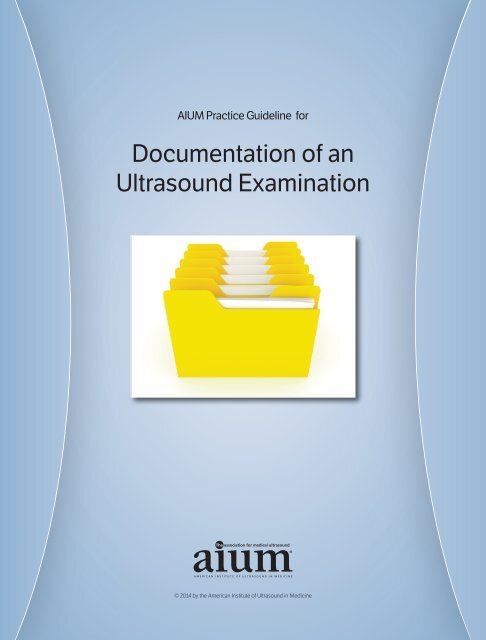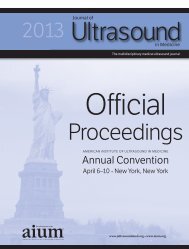AIUM Practice Guideline for Documentation of an Ultrasound ...
AIUM Practice Guideline for Documentation of an Ultrasound ...
AIUM Practice Guideline for Documentation of an Ultrasound ...
- No tags were found...
Create successful ePaper yourself
Turn your PDF publications into a flip-book with our unique Google optimized e-Paper software.
The Americ<strong>an</strong> Institute <strong>of</strong> <strong>Ultrasound</strong> in Medicine (<strong>AIUM</strong>) is a multidisciplinaryassociation dedicated to adv<strong>an</strong>cing the safe <strong>an</strong>d effective use<strong>of</strong> ultrasound in medicine through pr<strong>of</strong>essional <strong>an</strong>d public education,research, development <strong>of</strong> guidelines, <strong>an</strong>d accreditation. To promotethis mission, the <strong>AIUM</strong> is pleased to publish this updated <strong>AIUM</strong><strong>Practice</strong> <strong>Guideline</strong> <strong>for</strong> <strong>Documentation</strong> <strong>of</strong> <strong>an</strong> <strong>Ultrasound</strong> Examination.We are indebted to the m<strong>an</strong>y volunteers who contributed their time,knowledge, <strong>an</strong>d energy to bringing this document to completion.The <strong>AIUM</strong> represents the entire r<strong>an</strong>ge <strong>of</strong> clinical <strong>an</strong>d basic scienceinterests in medical diagnostic ultrasound, <strong>an</strong>d, with hundreds <strong>of</strong> volunteers,the <strong>AIUM</strong> has promoted the safe <strong>an</strong>d effective use <strong>of</strong> ultrasoundin clinical medicine <strong>for</strong> more th<strong>an</strong> 50 years. This document <strong>an</strong>dothers like it will continue to adv<strong>an</strong>ce this mission.<strong>Practice</strong> guidelines <strong>of</strong> the <strong>AIUM</strong> are intended to provide the medicalultrasound community with guidelines <strong>for</strong> the per<strong>for</strong>m<strong>an</strong>ce <strong>an</strong>d recording<strong>of</strong> high-quality ultrasound examinations. The guidelines reflectwhat the <strong>AIUM</strong> considers the minimum criteria <strong>for</strong> a complete examinationin each area but are not intended to establish a legal st<strong>an</strong>dard <strong>of</strong>care. <strong>AIUM</strong>-accredited practices are expected to generally follow theguidelines with recognition that deviations from these guidelines willbe needed in some cases, depending on patient needs <strong>an</strong>d availableequipment. <strong>Practice</strong>s are encouraged to go beyond the guidelines toprovide additional service <strong>an</strong>d in<strong>for</strong>mation as needed by their referringphysici<strong>an</strong>s <strong>an</strong>d patients.14750 Sweitzer Ln, Suite 100Laurel, MD 20707-5906 USA800-638-5352 • 301-498-4100www.aium.org2014—<strong>AIUM</strong> PRACTICE GUIDELINE—<strong>Documentation</strong> <strong>of</strong> <strong>an</strong> <strong>Ultrasound</strong> ExaminationCite this guideline as follows:Americ<strong>an</strong> Institute <strong>of</strong> <strong>Ultrasound</strong> in Medicine. <strong>AIUM</strong> practice guideline <strong>for</strong> documentation <strong>of</strong> <strong>an</strong> ultrasound examination .J <strong>Ultrasound</strong> Med 2014; 33:2219–2224. doi:10.7863/ultra.33.12.2219
2014—<strong>AIUM</strong> PRACTICE GUIDELINE—<strong>Documentation</strong> <strong>of</strong> <strong>an</strong> <strong>Ultrasound</strong> ExaminationI. IntroductionAdequate documentation <strong>an</strong>d communication by all members <strong>of</strong> the diagnostic ultrasoundhealth care team are essential <strong>for</strong> high-quality patient care. There should be a perm<strong>an</strong>ent record<strong>of</strong> the ultrasound examination <strong>an</strong>d its interpretation. Images <strong>of</strong> all relev<strong>an</strong>t areas defined in theparticular guideline, both normal <strong>an</strong>d abnormal, should be recorded in a retrievable <strong>for</strong>mat.Retention <strong>of</strong> the ultrasound images <strong>an</strong>d report should be consistent both with clinical needs<strong>an</strong>d with relev<strong>an</strong>t legal <strong>an</strong>d local health care facility requirements. Communication between theinterpreting physici<strong>an</strong> <strong>an</strong>d referring provider should be clear, timely, <strong>an</strong>d in a m<strong>an</strong>ner that minimizespotential errors. All communication should be per<strong>for</strong>med in a m<strong>an</strong>ner that respectspatient confidentiality. The reader is urged to refer also to the individual guideline <strong>for</strong> eachultrasound examination, since it may contain additional documentation requirements.II.<strong>Documentation</strong> Included <strong>for</strong> the <strong>Ultrasound</strong> ExaminationOfficial documentation <strong>for</strong> the ultrasound images should include but is not limited to the following:• Patient’s name <strong>an</strong>d other identifying in<strong>for</strong>mation.• Facility’s identifying in<strong>for</strong>mation.• Date <strong>of</strong> ultrasound examination.• Image orientation when appropriate.1If a worksheet is used <strong>an</strong>d retained, documentation should include:• Patient’s name <strong>an</strong>d other identifying in<strong>for</strong>mation.• Date <strong>of</strong> ultrasound examination.• Relev<strong>an</strong>t clinical in<strong>for</strong>mation <strong>an</strong>d/or current version <strong>of</strong> the appropriate InternationalClassification <strong>of</strong> Diseases (ICD) code.• Specific ultrasound examination requested.• Name <strong>of</strong> patient’s health care provider <strong>an</strong>d contact in<strong>for</strong>mation as appropriate.III.Final Report Provided by the Interpreting Physici<strong>an</strong>A signed final report <strong>of</strong> the ultrasound findings is included in the patient’s medical record <strong>an</strong>dis the definitive documentation <strong>of</strong> the study.The final report should include but is not limited to the following:• Patient’s name <strong>an</strong>d other identifying in<strong>for</strong>mation.• Name <strong>of</strong> patient’s health care provider.• Location <strong>of</strong> ultrasound facility <strong>an</strong>d contact in<strong>for</strong>mation.• Relev<strong>an</strong>t clinical in<strong>for</strong>mation, including indication <strong>for</strong> the examination <strong>an</strong>d/or currentversion <strong>of</strong> the appropriate ICD code.• Date <strong>of</strong> ultrasound examination.• Specific ultrasound examination per<strong>for</strong>med.• If endocavitary techniques are used, the method should be specified.www.aium.org
2014—<strong>AIUM</strong> PRACTICE GUIDELINE—<strong>Documentation</strong> <strong>of</strong> <strong>an</strong> <strong>Ultrasound</strong> Examination• The report should include comments on the components <strong>of</strong> the examination as outlinedin the relev<strong>an</strong>t practice guideline(s).• Appropriate <strong>an</strong>atomic <strong>an</strong>d sonographic terminology should be used. The use <strong>of</strong>acronyms <strong>an</strong>d abbreviations should be avoided. Variations from normal size shouldbe accomp<strong>an</strong>ied by measurements when appropriate (eg, org<strong>an</strong>omegaly <strong>an</strong>d masses).• Pertinent, commonly used <strong>an</strong>atomic measurements should be listed (eg, fetal biometry).• Limitations that compromise the quality <strong>of</strong> the examination should be noted (eg, highbody mass index).• Comparison with prior relev<strong>an</strong>t imaging studies if available.• A specific diagnosis or differential diagnosis should be included. An impression orconclusion should be included. A recommendation <strong>for</strong> follow-up studies should beprovided if clinically applicable.• The final report should be generated, signed, <strong>an</strong>d dated by the interpreting physici<strong>an</strong>in accord<strong>an</strong>ce with state <strong>an</strong>d federal requirements. Final reports should be availablewithin 24 hours <strong>of</strong> completion <strong>of</strong> the examination or, <strong>for</strong> nonemergency cases, by thenext business day.• Final reports should be tr<strong>an</strong>smitted to the patient’s health care provider in a timelyfashion <strong>an</strong>d in accord<strong>an</strong>ce with state <strong>an</strong>d federal requirements.2IV.Reporting <strong>of</strong> Nonroutine ResultsIn certain circumst<strong>an</strong>ces, such as immediate patient m<strong>an</strong>agement or a particular practice environment,a preliminary report <strong>of</strong> the ultrasound results may be conveyed directly to thepatient’s referring health care provider be<strong>for</strong>e the final report. The preliminary report mustcontain the patient’s identifying in<strong>for</strong>mation, provider’s in<strong>for</strong>mation, ultrasound facility, contactin<strong>for</strong>mation, pertinent clinical in<strong>for</strong>mation, date <strong>an</strong>d time <strong>of</strong> the ultrasound examination,<strong>an</strong>d specific ultrasound examination per<strong>for</strong>med. The preliminary report contains limited in<strong>for</strong>mation<strong>an</strong>d may not contain all <strong>of</strong> the results that will subsequently be found in the final report.Preliminary reports should be labeled as such <strong>an</strong>d should be archived, since clinical decisionsmay have been made based on a preliminary report. If a preliminary report has been issued, itshould be documented in the final report. Any signific<strong>an</strong>t discrep<strong>an</strong>cy between the preliminaryreport <strong>an</strong>d final report should be communicated to the patient’s provider <strong>an</strong>d highlighted inthe final report, including the date, time, <strong>an</strong>d method <strong>of</strong> communication.If results <strong>of</strong> the ultrasound examination are considered by the interpreting physici<strong>an</strong> to beimport<strong>an</strong>t <strong>an</strong>d unexpected, or require urgent intervention to ensure appropriate patient care,communication should occur directly between the interpreting physici<strong>an</strong> <strong>an</strong>d the patient’shealth care provider. Communication by phone or in person is preferred to allow verification<strong>of</strong> receipt <strong>an</strong>d discussion <strong>an</strong>d should occur in a timely m<strong>an</strong>ner in accord<strong>an</strong>ce with the patient’sclinical state <strong>an</strong>d the ultrasound findings, typically immediately after the examination.The institution’s protocol should be followed to minimize potential communication errors.The final report should include all <strong>of</strong> the elements noted in section III, as well as the date, time,<strong>an</strong>d method that the report was conveyed to the patient’s health care provider.www.aium.org
2014—<strong>AIUM</strong> PRACTICE GUIDELINE—<strong>Documentation</strong> <strong>of</strong> <strong>an</strong> <strong>Ultrasound</strong> ExaminationOfficial documentation <strong>of</strong> ultrasound images appropriate to the procedure being per<strong>for</strong>medshould be stored in the patient’s medical record. The ultrasound images should include but arenot limited to the following:• Patient’s identifying in<strong>for</strong>mation.• Facility’s identifying in<strong>for</strong>mation.• Procedure date.• Procedure site.Refer to the relev<strong>an</strong>t guideline <strong>for</strong> the specific ultrasound-guided procedure as they maycontain additional documentation requirements.AcknowledgmentsThis guideline was created <strong>an</strong>d revised by the Americ<strong>an</strong> Institute <strong>of</strong> <strong>Ultrasound</strong> in Medicine(<strong>AIUM</strong>).4<strong>AIUM</strong> Subcommittee MembersBry<strong>an</strong>n Bromley, MD, ChairAlex<strong>an</strong>der Levitov, MDVicki Noble, MD, RDMSCarl Otto, MDJoseph Wax, MD<strong>AIUM</strong> Clinical St<strong>an</strong>dards CommitteeJoseph Wax, MD, ChairJohn Pellerito, MD, Vice ChairSus<strong>an</strong> Ackerm<strong>an</strong>, MDS<strong>an</strong>dra Allison, MDGenevieve Bennett, MDBry<strong>an</strong>n Bromley, MDRob Goodm<strong>an</strong>, MB, BChirCharlotte Henningsen, MS, RT, RDMS, RVTAlex<strong>an</strong>der Levitov, MDResa Lewiss, MDVicki Noble, MD, RDMSDavid Paushter, MDDolores Pretorius, MDTatj<strong>an</strong>a Rundek, MD, PhDKhaled Sakhel, MDAnts Toi, MDIsabelle Wilkins, MDOriginal copyright 2002; revised 2007, 2008, 2014.www.aium.org
















